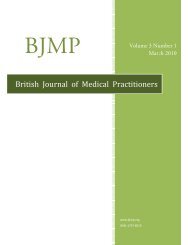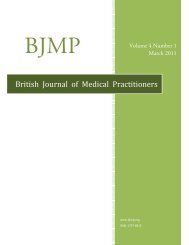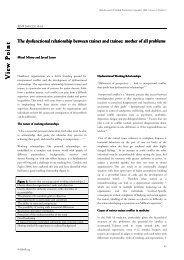R esearch A rticle - British Journal of Medical Practitioners
R esearch A rticle - British Journal of Medical Practitioners
R esearch A rticle - British Journal of Medical Practitioners
Create successful ePaper yourself
Turn your PDF publications into a flip-book with our unique Google optimized e-Paper software.
<strong>British</strong> <strong>Journal</strong> <strong>of</strong> <strong>Medical</strong> <strong>Practitioners</strong>, March 2013, Volume 6, Number 1<br />
stage is associated with a lower incidence <strong>of</strong> PPH and need for<br />
blood transfusion 11 . A longer acting oxytocin derivative,<br />
carbetocin, is licensed in the UK specifically for the indication<br />
<strong>of</strong> prevention <strong>of</strong> PPH in context <strong>of</strong> caesarean delivery.<br />
Randomised trials suggest that a single dose (100 mcg) <strong>of</strong><br />
carbetocin is at least as effective as oxytocin by infusion 12, 13 .<br />
Management <strong>of</strong> MOH<br />
Pregnant women are <strong>of</strong>ten young, healthy & have an increased<br />
blood volume <strong>of</strong> up to 20 % at term and therefore likely to<br />
compensate well to haemorrhage until the circulating blood<br />
volume is very low 14 . MEOWS are a useful bedside tool for<br />
predicting morbidity. A validation study <strong>of</strong> the CEMACH<br />
recommended modified early obstetric warning system<br />
(MEOWS) in all obstetric inpatients to track maternal<br />
physiological parameters, and to aid early recognition and<br />
treatment <strong>of</strong> the acutely unwell parturient. In addition, blood<br />
loss may sometimes be concealed and difficult to calculate.<br />
More commonly massive haemorrhage may be obvious; signs<br />
other than revealed haemorrhage include:<br />
• Tachycardia<br />
• Hypotension( BP may not drop until significant blood is lost)<br />
• Pallor<br />
• Oliguria<br />
• Cool peripheries<br />
• Lower abdominal pain<br />
Management <strong>of</strong> anticipated MOH<br />
On some occasions, cases at high risk <strong>of</strong> MOH can be<br />
predicted; e.g. caesarean section in a lady with a low lying<br />
placenta and previous uterine scar. These cases may be at a risk<br />
<strong>of</strong> placenta accreta and massive blood loss.<br />
• 2 large bore IV cannulae<br />
• Rapid infusion device or pressure bags in theatre<br />
• Blood warmer & warming blanket<br />
• Blood cross-matched & available<br />
• Consider preoperative invasive monitoring<br />
• Consider cell salvage if available (see below)<br />
• Consider interventional radiological procedures if available (<br />
see below)<br />
Management <strong>of</strong> unanticipated MOH<br />
Management involves four components, all <strong>of</strong> which must be<br />
undertaken SIMULTANEOUSLY: communication,<br />
resuscitation, monitoring and investigation, arresting the<br />
bleeding 9, 15 . Most maternity units in UK have CODE RED<br />
bleep system for alerting MOH.<br />
Communication & teamwork:<br />
Communication and teamwork are essential in cases <strong>of</strong> both<br />
anticipated & unanticipated maternal haemorrhage. This<br />
includes:<br />
• Call for help. Alert the midwife-in-charge, senior obstetrician<br />
& anaesthetist.<br />
• Alert Blood transfusion service & haematologist.<br />
• Alert portering service for transport <strong>of</strong> blood samples &<br />
collection <strong>of</strong> blood products<br />
• Check blood is available. In the UK 2-4 units <strong>of</strong> O-neg blood<br />
is kept on labour ward for emergency use.<br />
• Allocate roles to team members.<br />
• Ensure departmental guidelines exist for the management <strong>of</strong><br />
MOH & regularly practice ‘fire drills’.<br />
• Alert one member <strong>of</strong> the team to record events, fluids, drugs<br />
and vital signs 9 .<br />
• The use <strong>of</strong> standard form <strong>of</strong> words (such as ‘on going major<br />
obstetric haemorrhage’, ‘we need compatible blood now or<br />
group specific blood’) 9 .<br />
Goals <strong>of</strong> management:<br />
• Early identification <strong>of</strong> maternal bleed and institution <strong>of</strong> major<br />
haemorrhage drill<br />
• Rapid access to infusion <strong>of</strong> fluid in first instance with rapid<br />
availability & administration <strong>of</strong> blood.<br />
• Avoidance/limitation <strong>of</strong> complications <strong>of</strong> massive blood<br />
transfusion namely: acid/base disturbance, transfusion related<br />
acute lung injury (TRALI), hypocalcaemia, hyperkalaemia,<br />
hypothermia & thrombocytopenia.<br />
• Efficient team working & management decision making.<br />
Resuscitation & immediate management:<br />
• ABC, 100% oxygen<br />
• 2 large bore cannulae & bloods for X-match<br />
• Fluid resuscitation; crystalloid/colloid 2000mls via rapid<br />
infuser or pressure bags e.g. Level 1 Rapid infuser ( can<br />
achieve >500mls/min warmed fluid flow)<br />
• Fluid therapy and blood product transfusion 9<br />
• Crystalloid Up to 2 litres Hartmann’s solution<br />
• Colloid up to 1–2 litres colloid until blood arrives<br />
• Blood Crossmatched<br />
• If crossmatched blood is still unavailable, give<br />
uncrossmatched group-specific blood OR give ‘O RhD<br />
negative’ blood<br />
• Fresh frozen plasma 4 units for every 6 units <strong>of</strong> red cells or<br />
prothrombin time/activated partial thromboplastin time > 1.5<br />
x normal (12–15 ml/kg or total 1litres)<br />
• Platelets concentrates if platelet count < 50 x 10 9<br />
• Cryoprecipitate If fibrinogen < 1 g/l<br />
• Thromboelastography and rotational thromboelastometry<br />
coagulation tests: In most cases, medical and transfusion<br />
BJMP.org<br />
18







